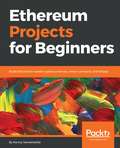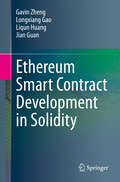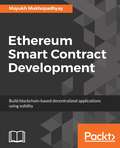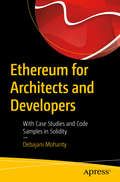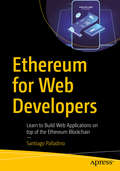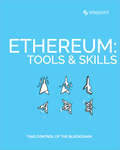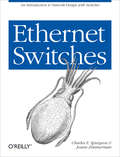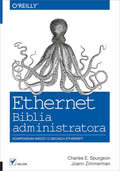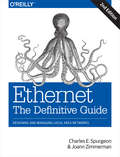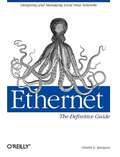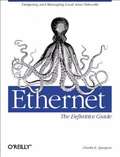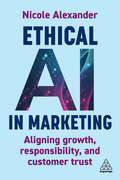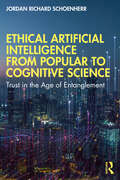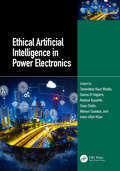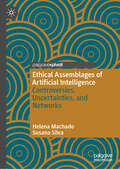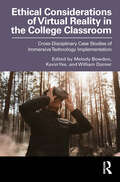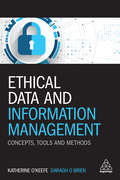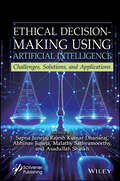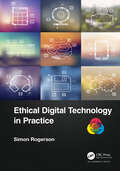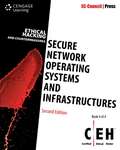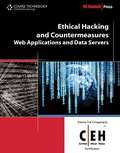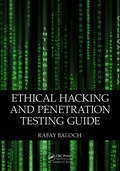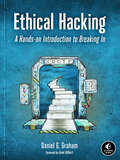- Table View
- List View
Ethereum Projects for Beginners: Build blockchain-based cryptocurrencies, smart contracts, and DApps
by Kenny VaneetveldeUnderstand the Ethereum platform to build distributed applications that are secured and decentralized using blockchain technologyKey FeaturesBuild your own decentralized applications using real-world blockchain examplesImplement Ethereum for building smart contracts and cryptocurrency applications with easy-to-follow projectsEnhance your application security with blockchainBook DescriptionEthereum enables the development of efficient, smart contracts that contain code. These smart contracts can interact with other smart contracts to make decisions, store data, and send Ether to others.Ethereum Projects for Beginners provides you with a clear introduction to creating cryptocurrencies, smart contracts, and decentralized applications. As you make your way through the book, you’ll get to grips with detailed step-by-step processes to build advanced Ethereum projects. Each project will teach you enough about Ethereum to be productive right away. You will learn how tokenization works, think in a decentralized way, and build blockchain-based distributed computing systems. Towards the end of the book, you will develop interesting Ethereum projects such as creating wallets and secure data sharing.By the end of this book, you will be able to tackle blockchain challenges by implementing end-to-end projects using the full power of the Ethereum blockchain.What you will learnDevelop your ideas fast and efficiently using the Ethereum blockchainMake writing and deploying smart contracts easy and manageableWork with private data in blockchain applicationsHandle large files in blockchain applicationsEnsure your decentralized applications are safeExplore how Ethereum development frameworks workCreate your own cryptocurrency or token on the Ethereum blockchainMake sure your cryptocurrency is ERC20-compliant to launch an ICOWho this book is forThis book is for individuals who want to build decentralized applications using blockchain technology and the power of Ethereum from scratch. Some prior knowledge of JavaScript is required, since most examples use a web frontend.
Ethereum Smart Contract Development in Solidity
by Longxiang Gao Gavin Zheng Liqun Huang Jian GuanThe general consensus is that BlockChain is the next disruptive technology, and Ethereum is the flagship product of BlockChain 2.0. However, coding and implementing business logic in a decentralized and transparent environment is fundamentally different from traditional programming and is emerging as a major challenge for developers.This book introduces readers to the Solidity language from scratch, together with case studies and examples. It also covers advanced topics and explains the working mechanism of smart contracts in depth. Further, it includes relevant examples that shed new light on the forefront of Solidity programming. In short, it equips readers with essential practical skills, allowing them to quickly catch up and start using Solidity programming.To gain the most from the book, readers should have already learned at least one object-oriented programming language
Ethereum Smart Contract Development: Build Blockchain-based Decentralized Applications Using Solidity
by Mayukh Mukhopadhyay<P><P>Become an Ethereum Blockchain developer using a blend of concepts and hands-on implementations <P><P>Key Features <P><P>Understand the Ethereum Ecosystem and its differences from its rich cousin Bitcoin <P><P>Explore the Solidity programming language and smart contract optimizations <P><P>Get a developer’s perspective of Blockchain-as-a-technology with exposure to common challenges faced while building decentralized applications <P><P>Book Description <P><P>Ethereum is a public, blockchain-based distributed computing platform featuring smart contract functionality. This book is your one-stop guide to blockchain and Ethereum smart contract development. <P><P>We start by introducing you to the basics of blockchain. You'll learn about hash functions, Merkle trees, forking, mining, and much more. Then you'll learn about Ethereum and smart contracts, and we'll cover Ethereum virtual machine (EVM) in detail. Next, you'll get acquainted with DApps and DAOs and see how they work. We'll also delve into the mechanisms of advanced smart contracts, taking a practical approach. <P><P>You'll also learn how to develop your own cryptocurrency from scratch in order to understand the business behind ICO. Further on, you'll get to know the key concepts of the Solidity programming language, enabling you to build decentralized blockchain-based applications. We'll also look at enterprise use cases, where you'll build a decentralized microblogging site. <P><P>At the end of this book, we discuss blockchain-as-a-service, the dark web marketplace, and various advanced topics so you can get well versed with the blockchain principles and ecosystem. <P><P>What you will learn <P><P>Know how to build your own smart contracts and cryptocurrencies <P><P>Understand the Solidity language <P><P>Find out about data types, control structure, functions, inheritance, mathematical operations, and much more <P><P>See the various types of forks and discover how they are related to Ethereum <P><P>Get to know the various concepts of web3.js and its APIs so you can build client-side apps <P><P>Build a DAO from scratch and acquire basic knowledge of DApps on Ethercast <P><P>Be guided through the project so you can optimize EVM for smart contracts <P><P>Build your own decentralized applications (DApps) by taking a practical approach <P><P>Who this book is for <P><P>If you want to know the ins and outs of the Ethereum network and build your own decentralized applications, then this book is what you need! This book is for anyone who is interested in blockchain and wants to become an Ethereum developer. It’s ideal for existing Ethereum developers who want to develop Ethereum using smart contracts. Basic knowledge of cryptography is expected but is not mandatory.
Ethereum Smart Contract Development: Build blockchain-based decentralized applications using solidity
by Mayukh MukhopadhyayBecome an Ethereum Blockchain developer using a blend of concepts and hands-on implementations Key Features Understand the Ethereum Ecosystem and its differences from its rich cousin Bitcoin Explore the Solidity programming language and smart contract optimizations Get a developer’s perspective of Blockchain-as-a-technology with exposure to common challenges faced while building decentralized applications Book Description Ethereum is a public, blockchain-based distributed computing platform featuring smart contract functionality. This book is your one-stop guide to blockchain and Ethereum smart contract development. We start by introducing you to the basics of blockchain. You'll learn about hash functions, Merkle trees, forking, mining, and much more. Then you'll learn about Ethereum and smart contracts, and we'll cover Ethereum virtual machine (EVM) in detail. Next, you'll get acquainted with DApps and DAOs and see how they work. We'll also delve into the mechanisms of advanced smart contracts, taking a practical approach. You'll also learn how to develop your own cryptocurrency from scratch in order to understand the business behind ICO. Further on, you'll get to know the key concepts of the Solidity programming language, enabling you to build decentralized blockchain-based applications. We'll also look at enterprise use cases, where you'll build a decentralized microblogging site. At the end of this book, we discuss blockchain-as-a-service, the dark web marketplace, and various advanced topics so you can get well versed with the blockchain principles and ecosystem. What you will learn Know how to build your own smart contracts and cryptocurrencies Understand the Solidity language Find out about data types, control structure, functions, inheritance, mathematical operations, and much more See the various types of forks and discover how they are related to Ethereum Get to know the various concepts of web3.js and its APIs so you can build client-side apps Build a DAO from scratch and acquire basic knowledge of DApps on Ethercast Be guided through the project so you can optimize EVM for smart contracts Build your own decentralized applications (DApps) by taking a practical approachWho this book is for If you want to know the ins and outs of the Ethereum network and build your own decentralized applications, then this book is what you need! This book is for anyone who is interested in blockchain and wants to become an Ethereum developer. It’s ideal for existing Ethereum developers who want to develop Ethereum using smart contracts. Basic knowledge of cryptography is expected but is not mandatory.
Ethereum for Architects and Developers: With Case Studies And Code Samples In Solidity
by Debajani MohantyExplore the Ethereum ecosystem step by step with extensive theory, labs, and live use cases. This book takes you through BlockChain concepts; decentralized applications; Ethereum’s architecture; Solidity smart contract programming with examples; and testing, debugging, and deploying smart contracts on your local machine and on the cloud. You’ll cover best practices for writing contracts with ample examples to allow you to write high-quality contracts with optimal usage of fuel. In later chapters, Ethereum for Architects and Developers covers use cases from different business areas, such as finance, travel, supply-chain, insurance, and land registry. Many of these sectors are explained with flowcharts, diagrams, and sample code that you can refer to and further enhance in live projects.By the end of the book, you will have enough information to use Ethereum to create value for your business processes and build foolproof data storage for smoother execution of business.What You Will Learn Discover key BlockChain conceptsMaster the architecture, building blocks, and ecosystem of EthereumDevelop smart contracts from scratch Debug, test, and deploy to test Take advantage of Ethereum in your business area Who This Book Is ForBlockChain developers and architects wanting to develop decentralized Ethereum applications or learn its architecture.
Ethereum for Web Developers: Learn to Build Web Applications on top of the Ethereum Blockchain
by Santiago PalladinoTechnology is constantly evolving, and blockchain is taking development to new places, as mobile did a decade ago – and Ethereum is the leading platform for creating this new wave of applications. This book reveals everything you need to create a robust decentralized application (more commonly known as DApp). Unlike other books on the topic, this one focuses on the web application layer, and guides you in creating great experiences on top of the Ethereum blockchain. You’ll review the challenges and differences involved in developing DApps as opposed to traditional web applications. After a brief introduction to blockchain history and Ethereum in particular, you’ll jump directly into building a sample decentralized application, to familiarize yourself with all the moving pieces. This book offers specific chapters on querying and rendering data from the blockchain, reacting to events, interacting with user accounts, sending transactions, managing gas, handling confirmations and reorganizations, and more. You will also find a chapter dedicated to Solidity that will give you the necessary means to understand and even build your own smart contracts. Other important topics covered include building backend servers that act as indexing layers, and managing storage efficiently with solutions like the interplanetary file system, or IPFS. Last but not least, you will find chapters that examine the biggest problems on Ethereum today: onboarding and scalability. These include the state of the art of the available strategies to tackle them, such as meta-transactions, smart accounts, ENS, state channels, sidechains, and more. What You'll Learn Connect to the blockchain from the browser and send transactions from client-sideBuild a web app that provides a read-only interface to a blockchain contract Create a wallet interface for arbitrary fungible tokens, displaying the user’s balance and allowing for simple transfers to other addressesDevelop a web app that stores large blobs of data off-chain, and keeps a reference to it on-chain (e.g. avatars, long text descriptions) Produce a web app that relies on a centralized server for indexing on-chain information to be presented to the user Who This Book Is ForWeb developers focused on client-side applications, with knowledge of JavaScript and HTML/CSS. You do not need any prior knowledge of Blockchain, Ethereum, or cryptocurrency.
Ethereum: Tools & Skills
by Bruno Skvorc Ahmed Bouchefra Mislav Javor Tonino JankovAs the Ethereum platform has grown, so has the ecosystem of tools that support it. In this book, we'll examine some of the most popular Ethereum tools, and walk you through how to use them when building your own Ethereum-based apps. It contains: Remix: Develop Smart Contracts for the Ethereum Blockchain by Ahmed BouchefraAn Introduction to Geth and Running Ethereum Nodes by Mislav JavorIntroducing Mist, a Human-friendly Geth Interface by Mislav JavorIntroducing Truffle, a Blockchain Smart Contract Suite by Mislav JavorQuality Solidity Code with OpenZeppelin and Friends by Tonino JankovTruffle: Testing Smart Contracts by Mislav JavorTruffle Migrations Explained by Mislav JavorFlattening Contracts and Debugging with Remix by Ahmed BouchefraDebugging with Truffle CLI by Mislav JavorUsing Puppeth, the Ethereum Private Network Manager by Bruno Skvorc This book is for anyone interested in using the Ethereum platform for development. It's advised that you read The Developer's Guide to Ethereum before reading this book if you are not familiar with blockchain technology.
Ethernet Switches: An Introduction to Network Design with Switches
by Joann Zimmerman Charles E. SpurgeonIf you’re ready to build a large network system, this handy excerpt from Ethernet: The Definitive Guide, Second Edition gets you up to speed on a basic building block: Ethernet switches. Whether you’re working on an enterprise or campus network, data center, or Internet service provider network, you’ll learn how Ethernet switches function and how they’re used in network designs.This brief tutorial also provides an overview of the most important features found in switches, from the basics to more advanced features found in higher-cost and specialized switches.Get an overview of basic switch operation, the spanning tree protocol, and switch performance issuesLearn about switch management and some of the most widely used switch featuresDiscover how a hierarchical design can help maintain stable network operationsDelve into special-purpose switches, such as multi-layer, access, stacking, and wireless access-point switchesLearn about advanced switch features designed for specific networking environmentsDive deeper into switches, with a list of protocol and package documentation
Ethernet. Biblia administratora
by Joann Zimmerman Charles E. SpurgeonKompendium wiedzy o sieciach Ethernet! Biblia administratora sieci Ethernet!Standard Ethernet powsta? w 1976 roku w o?rodku badawczym firmy Xerox. Wykorzystywany do budowy sieci lokalnych, znajduje zastosowanie praktycznie w ka?dym miejscu. Sieci Ethernet spotkasz zarówno w mieszkaniach czy domach, jak i w biurach czy centrach danych. W zale?no?ci od bud?etu, jakim dysponujesz, mo?esz zbudowa? sie? dostosowan? do w?asnych potrzeb. Nowoczesne sieci Ethernet pozwalaj? na niezawodne przesy?anie danych z ogromnymi pr?dko?ciami.W Twoje r?ce oddajemy bibli? wiedzy o sieciach Ethernet, która odpowie na wszystkie nurtuj?ce Ci? pytania oraz zaprezentuje nowoczesne techniki wykorzystania tych sieci. Przekonasz si?, jak wygl?da proces automatycznej negocjacji oraz jak zasila? urz?dzenia za pomoc? Ethernetu. W kolejnych rozdzia?ach znajdziesz charakterystyczne elementy popularnych sieci 10, 100 i 1000 Mb/s oraz niezwykle wydajnych sieci o pr?dko?ci dochodz?cej do 400 Gb/s. Trzecia cz??? tej ksi??ki zosta?a po?wi?cona budowie systemu Ethernet. Poznasz tu systemy okablowania strukturalnego, dost?pne kable, z??cza oraz prze??czniki. Ksi??ka ta jest obowi?zkow? pozycj? na pó?ce ka?dego administratora, który chce pozna? swoj? sie? od podszewki.Dzi?ki tej ksi??ce: poznasz histori? standardu Ethernet zrozumiesz zasad? jego dzia?ania zobaczysz, jaki potencja? kryj? sieci Ethernet nauczysz si? projektowa? wydajne rozwi?zania poznasz tajniki dzia?ania Twojej sieciCharles Spurgeon jest starszy architektem technologii na Uniwersytecie Stanu Texas w Austin, gdzie pracuje z systemem sieci kampusu obs?uguj?cej ponad 70 000 u?ytkowników w 200 budynkach. Pomaga? budowa? prototyp routerów ethernetowych, które sta?y si? podstaw? dla technologii urz?dze? produkowanych przez Cisco Systems.Joann Zimmerman jest in?ynierem oprogramowania. Jest twórczyni? i autork? dokumentacji kompilatorów, narz?dzi wytwarzania oprogramowania i oprogramowania do monitorowania sieci. Bra?a równie? udzia? w tworzeniu procesu zarz?dzania konfiguracj? i kompilacj? w kilku firmach.
Ethernet: Designing and Managing Local Area Networks
by Joann Zimmerman Charles E. SpurgeonGet up to speed on the latest Ethernet capabilities for building and maintaining networks for everything from homes and offices to data centers and server machine rooms. This thoroughly revised, comprehensive guide covers a wide range of Ethernet technologies, from basic operation to network management, based on the authors’ many years of field experience.When should you upgrade to higher speed Ethernet? How do you use switches to build larger networks? How do you troubleshoot the system? This book provides the answers. If you’re looking to build a scalable network with Ethernet to satisfy greater bandwidth and market requirements, this book is indeed the definitive guide.Examine the most widely used media systems, as well as advanced 40 and 100 gigabit EthernetLearn about Ethernet’s four basic elements and the IEEE standardsExplore full-duplex Ethernet, Power over Ethernet, and Energy Efficient EthernetUnderstand structured cabling systems and the components you need to build your Ethernet systemUse Ethernet switches to expand and improve network designDelve into Ethernet performance, from specific channels to the entire networkGet troubleshooting techniques for problems common to twisted-pair and fiber optic systems
Ethernet: The Definitive Guide
by Charles E. SpurgeonEthernet has been the flavor of choice for networking administrators since the early 1980s. Written by one of the foremost experts on Ethernet standards and configuration, Ethernet: The Definitive Guidehas all the information you need to set up and maintain a scalable local area network (LAN) using Ethernet. The book includes an introduction to Ethernet and sections on media systems, how to build your Ethernet system, performance analysis, and troubleshooting.
Ethernet: The Definitive Guide
by Charles SpurgeonEthernet is a core networking technology used by every high tech business. While the basic protocols have changed little, new options such as Fast Ethernet and Gigabit Ethernet have increased the complexity of the topic. Ethernet has been the flavor of choice for networking administrators since the early 1980s because of its ease of use and scalability. Written by one of the foremost experts on Ethernet standards and configuration, Charles E. Spurgeon, Ethernet: The Definitive Guide includes everything you need to know to set up and maintain an Ethernet network. Ethernet: The Definitive Guide teaches you everything you need to know about the IEEE 802.3 Ethernet standard and its protocols. The book is logically separated into five parts: Introduction to Ethernet provides a tour of basic Ethernet theory and operation, including a description of Ethernet frames, operation of the Media Access Control (MAC) protocol, full-duplex mode and auto-negotiation. Ethernet Media Systems is the heart of the book. This sectionof Ethernet: The Definitive Guide shows you how to build media-specific Ethernet networks, from a basic 10BASE-T Ethernet offering 10 Mbps over twisted-pair cables, to an advanced 1000BASE-X Gigabit Ethernet, providing up to 1 Gbps of data transfer over fiber optic cables. Building Your Ethernet System teaches you how to build twisted-pair and fiber optic media segments, as well as how to build your Ethernet using repeaters and hubs. Performance and Troubleshooting is divided into two chapters. The first describes both the performance of a given Ethernet channel, as well as the performance of the entire network system. The second includes a tutorial on troubleshooting techniques and describes the kinds of problems network administrators are likely to encounter. The last part of the book includes a complete glossary of terms used throughout the book, a resource list, descriptions of thick and thin coax-based Ethernet systems, a guide to AUI equipment installation and configuration, and a listing of troubleshooting numbers. This book is the definitive guide for anyone wanting to build a scalable local area network (LAN) using Ethernet.
Ethical AI in Marketing: Aligning Growth, Responsibility and Customer Trust
by Nicole AlexanderThe rapid evolution of AI presents marketers with unparalleled opportunities, but innovation inevitably invites scrutiny. To stay ahead, marketers must ensure their use of AI is both effective and ethical.Whether you're launching your first AI marketing initiative or scaling existing programs, this practical guide equips senior marketing professionals and aspiring leaders with the strategic insight and tactical expertise needed to navigate the complexities of AI-driven marketing. Offering a comprehensive roadmap for those responsible for implementing AI solutions, it explores how to harness AI's transformative power while upholding ethical standards and fostering consumer trust.Through real-world examples from organizations such as Ally, OSF Healthcare, Adobe, and Ipsos, the book examines how businesses are addressing key challenges, from navigating privacy considerations while delivering personalized experiences to developing governance frameworks that ensure ethical oversight without hindering innovation. It delves into the strategies that create sustainable competitive advantages through ethical AI adoption and provides a nuanced understanding of how companies at various stages of AI maturity are approaching responsible implementation. By illuminating both the challenges and opportunities that arise in AI adoption, this book offers marketers the tools and frameworks necessary to build trust, drive innovation, and ensure AI-driven marketing aligns with long-term ethical and business goals.
Ethical Artificial Intelligence from Popular to Cognitive Science: Trust in the Age of Entanglement
by Jordan Richard SchoenherrThis book offers a unique interdisciplinary perspective on the ethics of 'artificial intelligence' – autonomous, intelligent, (and connected) systems, or AISs, applying principles of social cognition to understand the social and ethical issues associated with the creation, adoption, and implementation of AISs. As humans become entangled in sociotechnical systems defined by human and artificial agents, there is a pressing need to understand how trust is created, used, and abused. Compounding the difficulty in answering these questions, stakeholders directly or indirectly affected by these systems differ in their motivations, understanding, and values. This volume provides a comprehensive resource to help stakeholders understand ethical issues of designing and implementing AISs using an ethical sensemaking approach. Starting with the general technical affordances of AIS, Dr. Jordan Richard Schoenherr considers the features of system design relating data integrity, selection and interpretation of algorithms, and the evolution processes that drive AISs innovation as a sociotechnological system. The poles of technophobia (algorithmic aversion) and technophilia (algorithmic preference) in the public perception of AISs are then described and considered against existing evidence, including issues ranging from the displacement and re-education needs of the human workforce, the impact of use of technology on interpersonal accord, and surveillance and cybersecurity. Ethical frameworks that provide tools for evaluating the values and outcomes of AISs are then reviewed, and how they can be aligned with ethical sensemaking processes identified by psychological science is explored. Finally, these disparate threads are brought together in a design framework. Also including sections on policies and guideline, gaming and social media, and Eastern philosophical frameworks, this is fascinating reading for students and academics in psychology, computer science, philosophy, and related areas, as well as professionals such as policy makers and those working with AI systems.
Ethical Artificial Intelligence from Popular to Cognitive Science: Trust in the Age of Entanglement
by Jordan Richard SchoenherrThis book offers a unique interdisciplinary perspective on the ethics of 'artificial intelligence' – autonomous, intelligent, (and connected) systems, or AISs, applying principles of social cognition to understand the social and ethical issues associated with the creation, adoption, and implementation of AISs.As humans become entangled in sociotechnical systems defined by human and artificial agents, there is a pressing need to understand how trust is created, used, and abused. Compounding the difficulty in answering these questions, stakeholders directly or indirectly affected by these systems differ in their motivations, understanding, and values. This volume provides a comprehensive resource to help stakeholders understand ethical issues of designing and implementing AISs using an ethical sensemaking approach. Starting with the general technical affordances of AIS, Dr. Jordan Richard Schoenherr considers the features of system design relating data integrity, selection and interpretation of algorithms, and the evolution processes that drive AISs innovation as a sociotechnological system. The poles of technophobia (algorithmic aversion) and technophilia (algorithmic preference) in the public perception of AISs are then described and considered against existing evidence, including issues ranging from the displacement and re-education needs of the human workforce, the impact of use of technology on interpersonal accord, and surveillance and cybersecurity. Ethical frameworks that provide tools for evaluating the values and outcomes of AISs are then reviewed, and how they can be aligned with ethical sensemaking processes identified by psychological science is explored. Finally, these disparate threads are brought together in a design framework.Also including sections on policies and guideline, gaming and social media, and Eastern philosophical frameworks, this is fascinating reading for students and academics in psychology, computer science, philosophy, and related areas, as well as professionals such as policy makers and those working with AI systems.
Ethical Artificial Intelligence in Power Electronics
by Keshav Kaushik Mariya Ouaissa Inam Ullah Khan Salma El Hajjami Tarandeep Kaur Bhatia Gayo DialloThis book focuses on the techniques of artificial intelligence that are mainly used in the power electronics field for the optimization of lost vehicle power. With the intention of optimizing the powerful energy of the vehicles and producing reliable energy, the most efficient methods, algorithms, and strategies of ethical artificial intelligence (AI) are being applied. By employing machine learning methods, the optimization of power energy in vehicles can be quickly recovered and managed efficiently. In today’s bustling world, power energy is indispensable for progress, yet in congested Vehicular Ad-hoc Networks (VANETs), vehicles often face power depletion and decreased efficiency. This book explores these challenges, encompassing not only power but also other critical power electronics within vehicles. We aim to introduce innovative approaches, leveraging ethical AI methods, to optimize energy performance in the face of these difficulties. Through this exploration, we seek to provide practical insights into navigating congested VANET environments while upholding ethical principles in technological advancements. Our book will discuss the current power energy concerns faced by vehicles and also contribute a novel strategy to overcome those concerns. The employment of ethical AI in vehicular power energy will undoubtedly improve the effectiveness and production of vehicles.
Ethical Assemblages of Artificial Intelligence: Controversies, Uncertainties, and Networks
by Helena Machado Susana SilvaThis book critically examines the ethical challenges of Artificial Intelligence (AI), focusing on facial recognition and AI-assisted reproductive technologies. It explores how these issues intertwine with social and political processes and power dynamics in digital societies. What defines ethical versus unethical in the realm of AI? Why do some ethical debates dominate, while others are overlooked? Which actors and institutions align or diverge in these discussions? To address these questions, the authors introduce the concept of "ethical assemblages," offering fresh perspectives on the complexities of AI ethics and their impact on socio-technoscientific structures.
Ethical Considerations of Virtual Reality in the College Classroom: Cross-Disciplinary Case Studies of Immersive Technology Implementation
by Melody Bowdon Kevin Yee William DornerEthical Considerations of Virtual Reality in the College Classroom collects case studies that address both pedagogical and ethical foundations of extended reality tools in postsecondary learning environments across disciplines. With today’s institutional programs and faculty leveraging cutting-edge virtual, augmented, and mixed reality opportunities to teach and promote achievement goals, it is imperative that new research into these technologies speaks directly to their challenges and affordances within broad academic settings. This book showcases real-world examples of faculty members who chronicle and develop their use of VR tools across learning contexts and student populations by creating their own digital experiences, adapting open-source tools, integrating commercial products, amplifying crucial course content, analyzing outcomes data, and more. Nontechnical readers will come away with a new understanding of key terms and concepts associated with virtual reality and essential heuristics for evaluating the ethical implications of immersive approaches.
Ethical Data and Information Management: Concepts, Tools and Methods
by Katherine O'Keefe Daragh O BrienInformation and how we manage, process and govern it is becoming increasingly important as organizations ride the wave of the big data revolution. Ethical Data and Information Management offers a practical guide for people in organizations who are tasked with implementing information management projects. It sets out, in a clear and structured way, the fundamentals of ethics, and provides practical and pragmatic methods for organizations to embed ethical principles and practices into their management and governance of information. Written by global experts in the field, Ethical Data and Information Management is an important book addressing a topic high on the information management agenda. Key coverage includes how to build ethical checks and balances into data governance decision making; using quality management methods to assess and evaluate the ethical nature of processing during design; change methods to communicate ethical values; how to avoid common problems that affect ethical action; and how to make the business case for ethical behaviours.
Ethical Decision-Making Using Artificial Intelligence
by Abhinav Juneja Sapna Juneja Rajesh Kumar Dhanaraj Malathy Sathyamoorthy Asadullah ShaikhEthical Decision-Making Using Artificial Intelligence: Challenges, Solutions, and Applications gives invaluable insights into the ethical complexities of artificial intelligence, empowering the navigation of critical decisions that shape our future in an era where AI’s influence on society is rapidly expanding. The significant impact of artificial intelligence on society cannot be overstated in a time of lightning-fast technical development and growing integration of AI into our daily lives. A new frontier of human potential has emerged with the development and application of AI technologies, pushing the limits of what is possible in the areas of innovation and efficiency. AI systems are increasingly trusted with complicated decisions that affect our security, well-being, and the fundamental foundation of our societies as they develop in intelligence and autonomy. These choices have substantial repercussions for both individuals and communities in a wide range of fields, including healthcare, finance, criminal justice, and transportation. The necessity for moral direction and deliberate decision-making procedures is critical as AI systems develop and become more independent. Ethical Decision-Making Using Artificial Intelligence: Challenges, Solutions, and Applications examines the complex relationship between artificial intelligence and the moral principles that guide its application. This book addresses fundamental concerns surrounding AI ethics, namely what moral standards ought to direct the creation and use of AI systems. In order to promote responsible AI development that is consistent with human values and goals, this book’s goal is to equip readers with the knowledge and skills they need to traverse the ethical landscape of AI decision-making.
Ethical Digital Technology in Practice
by Simon RogersonThis is an important book. Ethics is not an easy topic, and arguably the ethics of IT is less so—not leastdue to its potential for developing and evolving in ways that are either unforeseen or unimaginable . . . . Use this book as a practical resource, an informative and educational source of material in developing expertise, but also as an invaluable toolkit to support practical application of ethical thinking. —Declan Brady, President of the Irish Computer Society and a member of the Board of Directors of the Council of European Professional Informatics Societies Digital technology is about people. It is about those who plan, develop and implement applications which other people use and are affected by. It is about the impact on all these people as well as on the world at large. Ethical Digital Technology in Practice takes a real-world perspective to explore these impacts over time and discover ways in which to promote ethical digital technology through good practice. It draws upon the author’s published articles in trade magazines, professional journals and online blogs. These are synthesised into a blueprint which addresses, in a practical manner, the societal issues surrounding the increasing use and abuse of digital technology. It is a follow-up book to the author’s book The Evolving Landscape of Ethical Digital Technology, which has a researcher’s perspective. This book is a hands-on account of the computer revolution from 1995 to the current day when the world is increasingly dependent on digital technology. It explores some of the social and ethical issues that are part of this revolution. This is not a book about deep philosophical and technical concepts. Nor does it claim to be comprehensive. It is the author’s personal account of technological change and its effects on people. It is written by a boy who was smitten by computer technology at the age of 15, became a computer professional and subsequently spent many years showing young people how to develop and use digital technology in a good way. It is a book based upon the author’s engagement with practitioners, academics and students during the period as well as his continued fascination with this fantastic technology. Ethical Digital Technology in Practice is a book about the real world, of what has happened and what might happen as digital technology continues to pervade.
Ethical Hacking And Countermeasures: Secure Network Operating Systems and Infrastructures (Second Edition)
by EC-CouncilThe EC-Council|Press Ethical Hacking and Countermeasures series is comprised of four books covering a broad base of topics in offensive network security, ethical hacking, and network defense and countermeasures. The content of this series is designed to immerse the reader into an interactive environment where they will be shown how to scan, test, hack, and secure information systems. A wide variety of tools, viruses, and malware is presented in these books, providing a complete understanding of the tactics and tools used by hackers. The full series of books helps prepare readers to take and succeed on the C|EH certification exam from EC-Council.
Ethical Hacking and Countermeasures: Web Applications and Data Servers (Book #3)
by EC-Council StaffThe EC-Council - Press Ethical Hacking and Countermeasures series is intended for those studying to become security officers, auditors, security professionals, site administrators, and anyone who is concerned about or responsible for the integrity of the network infrastructure. The series includes a broad base of topics in offensive network security, ethical hacking, as well as network defense and countermeasures. Web Applications and Data Servers provides an overview of session hijacking, how to hack Web servers and database servers, as well as password-cracking techniques and Web application vulnerabilities.
Ethical Hacking and Penetration Testing Guide
by Rafay BalochRequiring no prior hacking experience, Ethical Hacking and Penetration Testing Guide supplies a complete introduction to the steps required to complete a penetration test, or ethical hack, from beginning to end. You will learn how to properly utilize and interpret the results of modern-day hacking tools, which are required to complete a penetration test. The book covers a wide range of tools, including Backtrack Linux, Google reconnaissance, MetaGooFil, dig, Nmap, Nessus, Metasploit, Fast Track Autopwn, Netcat, and Hacker Defender rootkit. Supplying a simple and clean explanation of how to effectively utilize these tools, it details a four-step methodology for conducting an effective penetration test or hack.Providing an accessible introduction to penetration testing and hacking, the book supplies you with a fundamental understanding of offensive security. After completing the book you will be prepared to take on in-depth and advanced topics in hacking and penetration testing. The book walks you through each of the steps and tools in a structured, orderly manner allowing you to understand how the output from each tool can be fully utilized in the subsequent phases of the penetration test. This process will allow you to clearly see how the various tools and phases relate to each other. An ideal resource for those who want to learn about ethical hacking but don‘t know where to start, this book will help take your hacking skills to the next level. The topics described in this book comply with international standards and with what is being taught in international certifications.
Ethical Hacking: A Hands-on Introduction to Breaking In
by Daniel G. GrahamA hands-on guide to hacking computer systems from the ground up, from capturing traffic to crafting sneaky, successful trojans.A crash course in modern hacking techniques, Ethical Hacking is already being used to prepare the next generation of offensive security experts. In its many hands-on labs, you&’ll explore crucial skills for any aspiring penetration tester, security researcher, or malware analyst. You&’ll begin with the basics: capturing a victim&’s network traffic with an ARP spoofing attack and then viewing it in Wireshark. From there, you&’ll deploy reverse shells that let you remotely run commands on a victim&’s computer, encrypt files by writing your own ransomware in Python, and fake emails like the ones used in phishing attacks. In advanced chapters, you&’ll learn how to fuzz for new vulnerabilities, craft trojans and rootkits, exploit websites with SQL injection, and escalate your privileges to extract credentials, which you&’ll use to traverse a private network. You&’ll work with a wide range of professional penetration testing tools—and learn to write your own tools in Python—as you practice tasks like: • Deploying the Metasploit framework&’s reverse shells and embedding them in innocent-seeming files • Capturing passwords in a corporate Windows network using Mimikatz • Scanning (almost) every device on the internet to find potential victims • Installing Linux rootkits that modify a victim&’s operating system • Performing advanced Cross-Site Scripting (XSS) attacks that execute sophisticated JavaScript payloads Along the way, you&’ll gain a foundation in the relevant computing technologies. Discover how advanced fuzzers work behind the scenes, learn how internet traffic gets encrypted, explore the inner mechanisms of nation-state malware like Drovorub, and much more. Developed with feedback from cybersecurity students, Ethical Hacking addresses contemporary issues in the field not often covered in other books and will prepare you for a career in penetration testing. Most importantly, you&’ll be able to think like an ethical hacker: someone who can carefully analyze systems and creatively gain access to them.
